Geology 307: Igneous and Metamorphic Petrology (Spring 2015)
Item set
- Title
- Geology 307: Igneous and Metamorphic Petrology (Spring 2015)
- Creator
- Tamara Carley
- Date Created
- 22 January 2015
Items
-
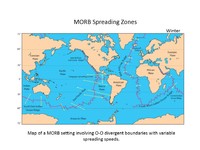
-
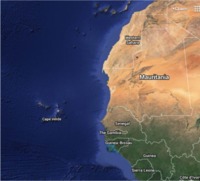 The Cape Verde Islands are located to the east of the African Continental margin. The Cape Verde Islands are in an intraplate tectonic setting. This means that the islands were not produced at a divergent margin (Mid-ocean ridge) setting or a convergent margin (island arc) setting. Instead, they were produced within the margins of a plate by hotspot volcanism. The Cape Verde Islands were produced within the African Plate.
The Cape Verde Islands are located to the east of the African Continental margin. The Cape Verde Islands are in an intraplate tectonic setting. This means that the islands were not produced at a divergent margin (Mid-ocean ridge) setting or a convergent margin (island arc) setting. Instead, they were produced within the margins of a plate by hotspot volcanism. The Cape Verde Islands were produced within the African Plate. -
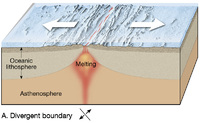
-
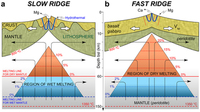
-
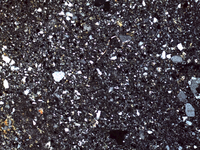 Hornfel: This rock was collected directly beneath the diabase boulder and represents a contact metamorphosed portion of the underlying strata. It was collected at 40.5620N 75.12608W
Hornfel: This rock was collected directly beneath the diabase boulder and represents a contact metamorphosed portion of the underlying strata. It was collected at 40.5620N 75.12608W -
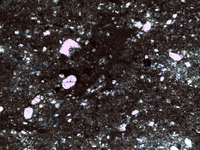 A small rock drill core from the metamorphic contact between the diabase and base rock of red siltstone. The sample is fine-grained and dark colored indicating mostly mafic minerals. The thin section consists of a dark very fine grained matrix with mostly hypidioblastic quartz porphyroblasts. There is surprisingly no banding. There is one piece of sillimanite indicating high metamorphic grade. There are also some poikiloblasts. Location 40.5621 N, 75.1261 W.
A small rock drill core from the metamorphic contact between the diabase and base rock of red siltstone. The sample is fine-grained and dark colored indicating mostly mafic minerals. The thin section consists of a dark very fine grained matrix with mostly hypidioblastic quartz porphyroblasts. There is surprisingly no banding. There is one piece of sillimanite indicating high metamorphic grade. There are also some poikiloblasts. Location 40.5621 N, 75.1261 W. -
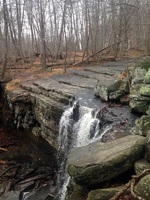 Piece of diabase taken from the center of the boulder field at Ringing Rocks Park, Pennsylvania. In hand sample, exterior of the rock appears felsic, however, it is truly mafic. Once broken, the internals of the rock reveal a porphyritic texture. Coordinates - (40.5625 N, 075.1294 W)
Piece of diabase taken from the center of the boulder field at Ringing Rocks Park, Pennsylvania. In hand sample, exterior of the rock appears felsic, however, it is truly mafic. Once broken, the internals of the rock reveal a porphyritic texture. Coordinates - (40.5625 N, 075.1294 W) -
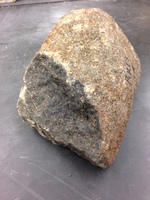 This sample is from the boulder field at Ringing Rocks. The coordinates of the location where it was found are (40.5625N, 75.1294W). I chose this sample because it contains a weathering rind. I would like to find out which minerals are present in the inside of the rock and which are not present in the weathering rind.
This sample is from the boulder field at Ringing Rocks. The coordinates of the location where it was found are (40.5625N, 75.1294W). I chose this sample because it contains a weathering rind. I would like to find out which minerals are present in the inside of the rock and which are not present in the weathering rind. -
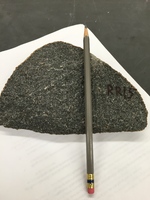 RR-15 Hand Sample- Dark Gray Diabase Phaneritic with tan grains possibly augite Locations: RR7- base of waterfall, in metamorphosed section from when diabase sheet was intruded and contact metamorphosed preexisting rock. Sample taken from about 15 yards from contact and chosen because it was a hard, solid rock next to a more crumbly rock that was less metamorphosed and probably different than at other areas of metamorphosed rock around it. (40.5623N/75.1261W) RR-15- Chosen from far end of boulder field from entrance. I wanted a rock far away from where everyone else was collecting them. (40.5632N/75.12999W) Thin Section: Interstitial plagioclase among grains of augite -- notable amphiboles, pyroxenes--possibly some biotite and olivine if it has not been weathered away. Series of 3 microscope slide photos (PPL and XPL), show grain coarsening upward away from igneous/metamorphic contact to boulder field. Left photo is RR-6 (Will DeBarba), diabase from right next to the igneous-metamorphic contact, showing small grain size and considerable feldspar microlites. Middle photo is RR-5 (Emma Sosa), diabase from 30 feet into the sill from the contact, showing a larger grain size of similar minerals and less interstitial plagioclase due to other crystals taking up the space. The right photo is RR-15 (John Onorati), diabase from the ringing rocks boulder field, approximately .22 miles from the contact (google earth), and showing a much larger grain size compared to the other two samples--as well as a larger variety of minerals.
RR-15 Hand Sample- Dark Gray Diabase Phaneritic with tan grains possibly augite Locations: RR7- base of waterfall, in metamorphosed section from when diabase sheet was intruded and contact metamorphosed preexisting rock. Sample taken from about 15 yards from contact and chosen because it was a hard, solid rock next to a more crumbly rock that was less metamorphosed and probably different than at other areas of metamorphosed rock around it. (40.5623N/75.1261W) RR-15- Chosen from far end of boulder field from entrance. I wanted a rock far away from where everyone else was collecting them. (40.5632N/75.12999W) Thin Section: Interstitial plagioclase among grains of augite -- notable amphiboles, pyroxenes--possibly some biotite and olivine if it has not been weathered away. Series of 3 microscope slide photos (PPL and XPL), show grain coarsening upward away from igneous/metamorphic contact to boulder field. Left photo is RR-6 (Will DeBarba), diabase from right next to the igneous-metamorphic contact, showing small grain size and considerable feldspar microlites. Middle photo is RR-5 (Emma Sosa), diabase from 30 feet into the sill from the contact, showing a larger grain size of similar minerals and less interstitial plagioclase due to other crystals taking up the space. The right photo is RR-15 (John Onorati), diabase from the ringing rocks boulder field, approximately .22 miles from the contact (google earth), and showing a much larger grain size compared to the other two samples--as well as a larger variety of minerals. -
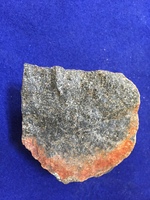 A piece of diabase taken from the middle part of the boulder field at Ringing Rocks, PA. Some visible minerals in the hand sample of the rock can be identified as plagioclase feldspar, micas, and some lithic fragments. The rock appears to be oxidized because of the rusty red patches.
A piece of diabase taken from the middle part of the boulder field at Ringing Rocks, PA. Some visible minerals in the hand sample of the rock can be identified as plagioclase feldspar, micas, and some lithic fragments. The rock appears to be oxidized because of the rusty red patches. -
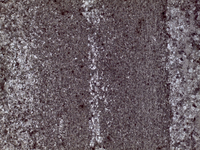 Hand Sample: Metamorphosed Redbed with alternating light and dark banding. Sample is too fine grained to clearly make out minerals in hand sample, but light bands are likely dominated by quartz. Thin section: Major compositional differences between light and dark bands. Light bands have large grains of quartz, predominately. Dark bands have a brown groundmass with some small quartz grains.
Hand Sample: Metamorphosed Redbed with alternating light and dark banding. Sample is too fine grained to clearly make out minerals in hand sample, but light bands are likely dominated by quartz. Thin section: Major compositional differences between light and dark bands. Light bands have large grains of quartz, predominately. Dark bands have a brown groundmass with some small quartz grains. -
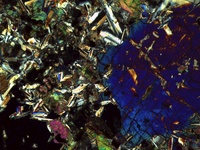 During our field trip to Ringing Rocks on April 9, 2015 we took multiple samples and field notes from the historic diabase from this location. This hand sample was taken from the boulder field margin and a sample was then cut to create a thin section of the sample. The sample displays many mafic minerals contained within it, typical to an early formed magma. The sample was taken from 40.563272N/ 75.129980W. A possible hypothesis for this sample is that it was within the location of the bottom of the intruding magma sill. This is due to the abundance of large olivine phenocryts within the sample. These olivine crystals likely collected at the bottom of the sill of magma diabase due to fractional crystallization. The olivine crystals formed early within the stages of the melt cooling and likely fell to the base of the magma chamber within the sill. This would cause large amounts of olivine crystals to be present within the hand sample and the thin section. Within the thin section, olivine crystals show fracturing and inter-growths of plagioclase feldspar and hornblende. This likely describes this portion of the sill was uplifted, releasing pressure quickly, and resulted in cracks in the olivine phenocrysts as well as smaller growths of plagioclase feldspars and pyroxene microlites. However without further samples of multiple depths and locations of the diabase sill, it cannot be determined that this specific sequence of events occurred.
During our field trip to Ringing Rocks on April 9, 2015 we took multiple samples and field notes from the historic diabase from this location. This hand sample was taken from the boulder field margin and a sample was then cut to create a thin section of the sample. The sample displays many mafic minerals contained within it, typical to an early formed magma. The sample was taken from 40.563272N/ 75.129980W. A possible hypothesis for this sample is that it was within the location of the bottom of the intruding magma sill. This is due to the abundance of large olivine phenocryts within the sample. These olivine crystals likely collected at the bottom of the sill of magma diabase due to fractional crystallization. The olivine crystals formed early within the stages of the melt cooling and likely fell to the base of the magma chamber within the sill. This would cause large amounts of olivine crystals to be present within the hand sample and the thin section. Within the thin section, olivine crystals show fracturing and inter-growths of plagioclase feldspar and hornblende. This likely describes this portion of the sill was uplifted, releasing pressure quickly, and resulted in cracks in the olivine phenocrysts as well as smaller growths of plagioclase feldspars and pyroxene microlites. However without further samples of multiple depths and locations of the diabase sill, it cannot be determined that this specific sequence of events occurred. -
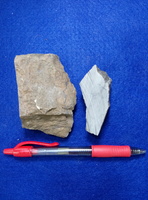 The sample is a basaltic igneous rock extruded during divergent volcanism as the result of the break up of Pangea. Samples were collected by Dr. Kira Lawrence in the Northeast corner of the Meriden Quadrangle (41°37.37'N, 72°44.33'W). The approximate age of the samples based on prior work is ~ 201 Ma. The sample is a dark gray to black aphanitic basalt with now phenocrysts visible in hand sample. Under 4x and 10x magnification using a petrographic microscope, grains of plagioclase feldspar and pyroxenes can be discerned. The purpose of this sample being cataloged is to provide a sample for comparison for intrusive samples collected at the Ringing Rocks diabase.
The sample is a basaltic igneous rock extruded during divergent volcanism as the result of the break up of Pangea. Samples were collected by Dr. Kira Lawrence in the Northeast corner of the Meriden Quadrangle (41°37.37'N, 72°44.33'W). The approximate age of the samples based on prior work is ~ 201 Ma. The sample is a dark gray to black aphanitic basalt with now phenocrysts visible in hand sample. Under 4x and 10x magnification using a petrographic microscope, grains of plagioclase feldspar and pyroxenes can be discerned. The purpose of this sample being cataloged is to provide a sample for comparison for intrusive samples collected at the Ringing Rocks diabase. -
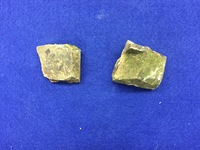
-
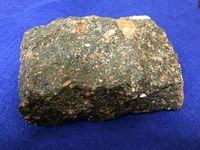 This is a Pyroclastic Obsidian with Xenolith Inclusions
This is a Pyroclastic Obsidian with Xenolith Inclusions -
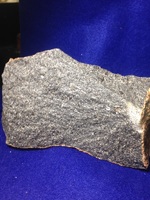 Hand sample: Phaneritic olivene diabase. Phenocrysts include olivene and pyroxene. Weathering textures include channels/grooves, 'mudcrack'-type cracking, and pitting. Latitude: 40.5625 Longitude: 75.1292
Hand sample: Phaneritic olivene diabase. Phenocrysts include olivene and pyroxene. Weathering textures include channels/grooves, 'mudcrack'-type cracking, and pitting. Latitude: 40.5625 Longitude: 75.1292 -
 Salt and pepper diabase with brown weathered faces from 40.5625 N, 72.1264 W
Salt and pepper diabase with brown weathered faces from 40.5625 N, 72.1264 W -
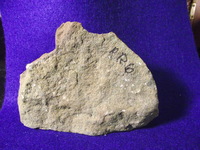 Dark gray diabase has many fine-grained cumulus augite cystals with interstitial plagioclase feldspar inbetween the crystals. There are also some accessory minerals, possibly biotite. This rock was found in the sill at Ringing Rocks at the contact with the metamorphic rocks (40.56200 N, 75.12608 W).
Dark gray diabase has many fine-grained cumulus augite cystals with interstitial plagioclase feldspar inbetween the crystals. There are also some accessory minerals, possibly biotite. This rock was found in the sill at Ringing Rocks at the contact with the metamorphic rocks (40.56200 N, 75.12608 W). -
 Hand sample: -Diabase -Phaneritic crystals dominated by black mafic minerals -Notable tan mineral, possibly quartz. Few crystals of biotite -In thin section able to distinguish Calsic plag, pyroxenes, amphibolies, and biotite. Also low birefringence mineral without cleavage, possibly quartz Location -Ringing rocks boulder field, about half a kilometer from contact of the sill with country rock. - Coordinates: 40 33 45N 75 71 45W Significance -This rock was a representative example of the boulder field and may help us determining if there are any textural or chemical differences between this sample and those closer and further from the contact.
Hand sample: -Diabase -Phaneritic crystals dominated by black mafic minerals -Notable tan mineral, possibly quartz. Few crystals of biotite -In thin section able to distinguish Calsic plag, pyroxenes, amphibolies, and biotite. Also low birefringence mineral without cleavage, possibly quartz Location -Ringing rocks boulder field, about half a kilometer from contact of the sill with country rock. - Coordinates: 40 33 45N 75 71 45W Significance -This rock was a representative example of the boulder field and may help us determining if there are any textural or chemical differences between this sample and those closer and further from the contact. -
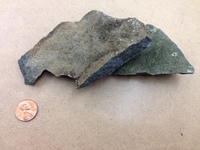 A small piece of a diabase boulder from Ringing Rocks State park (40.56217N 75.12632S). This boulder is believed to be a part of a large sill that intruded into a metamorphic country rock. This rock was taken about 30 feet from the known metamorphic-igneous contact zone. The rock is dark in color and fine-grained. Individual minerals can be seen by the naked eye but they are too small to identify.
A small piece of a diabase boulder from Ringing Rocks State park (40.56217N 75.12632S). This boulder is believed to be a part of a large sill that intruded into a metamorphic country rock. This rock was taken about 30 feet from the known metamorphic-igneous contact zone. The rock is dark in color and fine-grained. Individual minerals can be seen by the naked eye but they are too small to identify. -
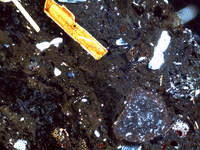 This is a pyroclastic rock from violent eruptions causing fragments to become welded within the rock. It contains xenoliths inclusions of country rock. The black material contained within the rock is compressed pumice, called fiamme. Pumice forms from rapid cooling of explosive volcanic eruptions and the xenoliths also contained within the rock are due to continued increased temperature and overlying pressure. The black material in thin section represents volcanic glass from the compacted pumice. This is typical to violent eruptions and quick cooling of generally silicic rich magmas. There are visible grains in thin section of plagioclase that displays cracks due to abrupt release of overlying pressure and rapid decrease in temperature, something characteristic to a quick eruption on a continental margin. This rock is called a welded tuff and occurs close to the eruption vent of a volcano where overlying sediment can cause pressure to increase and compress the fragments. This makes sense because as the oceanic plate subducted and volcanoes emerged on the continental plate volcanic eruptions occur and this welded tuff would be located close to the slope of one of these continental volcanoes.
This is a pyroclastic rock from violent eruptions causing fragments to become welded within the rock. It contains xenoliths inclusions of country rock. The black material contained within the rock is compressed pumice, called fiamme. Pumice forms from rapid cooling of explosive volcanic eruptions and the xenoliths also contained within the rock are due to continued increased temperature and overlying pressure. The black material in thin section represents volcanic glass from the compacted pumice. This is typical to violent eruptions and quick cooling of generally silicic rich magmas. There are visible grains in thin section of plagioclase that displays cracks due to abrupt release of overlying pressure and rapid decrease in temperature, something characteristic to a quick eruption on a continental margin. This rock is called a welded tuff and occurs close to the eruption vent of a volcano where overlying sediment can cause pressure to increase and compress the fragments. This makes sense because as the oceanic plate subducted and volcanoes emerged on the continental plate volcanic eruptions occur and this welded tuff would be located close to the slope of one of these continental volcanoes. -
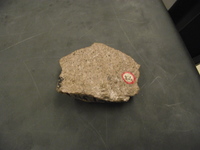 Granite
Granite -
 Macroscopic: This hand sample is a grey to dark-grey intermediate intrusive igneous rock composed principally of plagioclase feldspar (typically andesine), biotite, hornblende, and/or pyroxene. This sample has a phaneritic texture which is common to diorite. Microscopic: In planar light, the thin section sample clearly shows the phaneritic texture (Biotite and Hornblende and other various minerals show up as brown/green/light green or brown). In polarized light, the matrix reveals the plagioclase minerals. The majority of crystals (primarily biotite and hornblende) are anhedral - at one point being re-fractionated into the melt (this re-fractionation was cut short at eruption when the molten rock solidified); plagioclase crystals grew into the spaces between what remained of the hornblende and biotite crystals.
Macroscopic: This hand sample is a grey to dark-grey intermediate intrusive igneous rock composed principally of plagioclase feldspar (typically andesine), biotite, hornblende, and/or pyroxene. This sample has a phaneritic texture which is common to diorite. Microscopic: In planar light, the thin section sample clearly shows the phaneritic texture (Biotite and Hornblende and other various minerals show up as brown/green/light green or brown). In polarized light, the matrix reveals the plagioclase minerals. The majority of crystals (primarily biotite and hornblende) are anhedral - at one point being re-fractionated into the melt (this re-fractionation was cut short at eruption when the molten rock solidified); plagioclase crystals grew into the spaces between what remained of the hornblende and biotite crystals. -
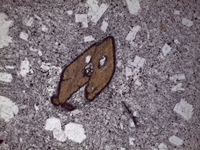 MEGASCOPIC: shows black hornblende crystals sprinkled in a light-gray groundmass MICROSCOPIC: strongly zoned intermediate plagioclase forms phenocrysts and microphenocrysts. Oxyhornblende phenocrysts have generally narrow reaction rims of a very fine magnetite and pyroxene. A few microphenocrysts of the amphibole are entirely covered and some are corroded and segmentally veined by matrix material. The fine-grained matrix is composed of plagioclase microlites in a slightly fluidal pattern, minut prisms of clinopyroxene and dots of magnetite.
MEGASCOPIC: shows black hornblende crystals sprinkled in a light-gray groundmass MICROSCOPIC: strongly zoned intermediate plagioclase forms phenocrysts and microphenocrysts. Oxyhornblende phenocrysts have generally narrow reaction rims of a very fine magnetite and pyroxene. A few microphenocrysts of the amphibole are entirely covered and some are corroded and segmentally veined by matrix material. The fine-grained matrix is composed of plagioclase microlites in a slightly fluidal pattern, minut prisms of clinopyroxene and dots of magnetite. -
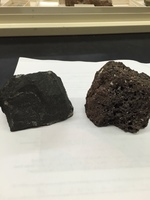 Basalt Macroscopically: A black aphanitic rock. Scoria Macroscopically: A cellular lava that varies in color from reddish brown to brownish black. Tiny glass crystals of feldspar can be seen with a lens in some specimen. Scoria Microscopically: A highly vesicular rock with calcic plagioclase phenocrysts set abundantly and diversely in a brown hypohyaline matrix. The phenocrysts contain glass blebs, some crystallographically oriented. Compositional zoning is present, and in some a rim may be free of glass inclusions. The matrix contains plagioclase microlites(many also zoned), dark red-brown essentially opaque glass, with local patches of formless devitrified material.
Basalt Macroscopically: A black aphanitic rock. Scoria Macroscopically: A cellular lava that varies in color from reddish brown to brownish black. Tiny glass crystals of feldspar can be seen with a lens in some specimen. Scoria Microscopically: A highly vesicular rock with calcic plagioclase phenocrysts set abundantly and diversely in a brown hypohyaline matrix. The phenocrysts contain glass blebs, some crystallographically oriented. Compositional zoning is present, and in some a rim may be free of glass inclusions. The matrix contains plagioclase microlites(many also zoned), dark red-brown essentially opaque glass, with local patches of formless devitrified material.
